A) industrial nitrogen fixation
B) nitrogen lost to the atmosphere
C) internal nitrogen cycling in the oceans
D) nitrogen fixation by bacteria
Correct Answer

verified
Correct Answer
verified
Multiple Choice
Use the following figure to answer the question. 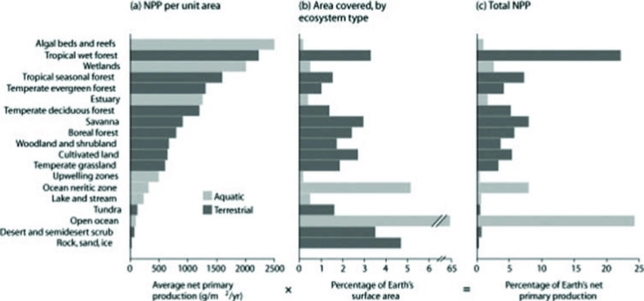 Which ecosystem, if completely converted by humans to cultivated land, would have the largest negative impact on total NPP?
Which ecosystem, if completely converted by humans to cultivated land, would have the largest negative impact on total NPP?
A) temperate evergreen forest
B) boreal forest
C) savanna
D) woodland and shrubland
Correct Answer

verified
Correct Answer
verified
Multiple Choice
As part of the carbon cycle, which of the following reservoirs of carbon is the largest?
A) the ocean
B) the atmosphere
C) fossilized plant and animal remains (coal, oil, and natural gas)
D) sediments and sedimentary rocks
Correct Answer

verified
Correct Answer
verified
Multiple Choice
Which of the following are the main forms of chemical inputs and outputs that are recycled within an ecosystem?
A) soil elements, water, oxygen, carbon dioxide, chemicals within detritus (dead organisms)
B) sunlight and heat
C) inorganic and organic compounds
D) water, nitrogen, phosphorus, carbon, and heat
Correct Answer

verified
Correct Answer
verified
Multiple Choice
Which of the following is an example of biological augmentation?
A) adding nitrogen-fixing microorganisms to a degraded ecosystem to increase nitrogen availability
B) using a bulldozer to regrade a strip mine
C) dredging a river bottom to remove contaminated sediments
D) adding fertilizer to soil poor in nutrients to increase plant growth
Correct Answer

verified
Correct Answer
verified
Multiple Choice
Use the following figure to answer the question. 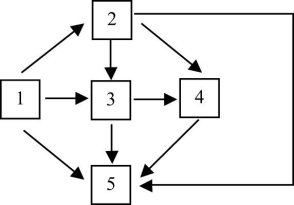 Food web for a particular terrestrial ecosystem (arrows represent energy flow and numbers represent species)
Based on this food web, which species is most likely a decomposer?
Food web for a particular terrestrial ecosystem (arrows represent energy flow and numbers represent species)
Based on this food web, which species is most likely a decomposer?
A) 1
B) 2
C) 3
D) 5
Correct Answer

verified
Correct Answer
verified
Multiple Choice
Which of the following statements about energy is most accurate?
A) Plants reduce the amount of total energy in a system during the conversion of energy from solar to chemical forms.
B) The total amount of energy in an ecosystem changes during the process of photosynthesis and respiration as matter is lost.
C) The amount of energy stored in organic molecules must equal the total solar energy intercepted by the plant minus the amounts reflected and dissipated as heat.
D) Energy can be created, but not destroyed.
Correct Answer

verified
Correct Answer
verified
Multiple Choice
Use the following figure to answer the question. 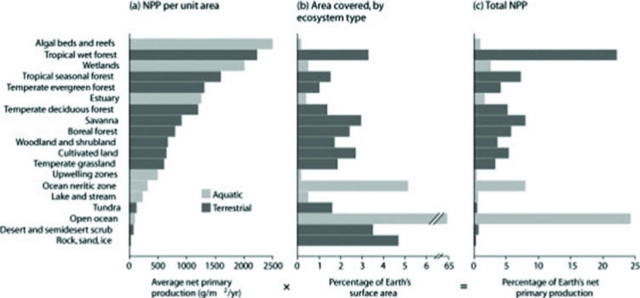 Which habitat type in the figure covers the largest area?
Which habitat type in the figure covers the largest area?
A) tropical wet forest
B) rock, sand, ice
C) algal beds and reefs
D) open ocean
Correct Answer

verified
Correct Answer
verified
Multiple Choice
How is net ecosystem production (NEP) typically estimated in ecosystems?
A) by detecting the amount of heat energy released by the ecosystem
B) by measuring gas exchange from vegetation as well as estimates of respiration by all other organisms
C) by measuring the rate of decomposition by detritivores
D) by calculating the annual total of incoming solar radiation per unit of area
Correct Answer

verified
Correct Answer
verified
Multiple Choice
Use the following figure to answer the question. 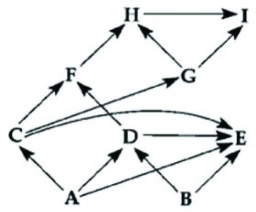 Diagram of a food web (arrows represent energy flow and letters represent species)
If the figure represents a marine food web, tertiary consumers are most likely ________.
Diagram of a food web (arrows represent energy flow and letters represent species)
If the figure represents a marine food web, tertiary consumers are most likely ________.
A) C
B) D
C) E
D) H
Correct Answer

verified
Correct Answer
verified
Multiple Choice
What advantage would there be for an ecosystem ecologist to measure net ecosystem production (NEP) instead of net primary production (NPP) ?
A) NPP cannot be expressed in energy/unit of area/unit of time.
B) NEP can be expressed in terms of carbon fixed by photosynthesis for an entire ecosystem, minus respiration by producers, allowing the measurement of net CO2 flux.
C) NEP represents the amount of energy from light converted to chemical energy, minus the energy used by all organisms for cellular respiration, which could indicate whether or not carbon is being stored.
D) NPP shows the rate at which the standing crop is utilized by consumers.
Correct Answer

verified
Correct Answer
verified
Multiple Choice
Use the following figure to answer the question. 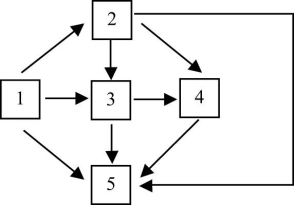 Food web for a particular terrestrial ecosystem (arrows represent energy flow and numbers represent species)
In the food web, if species 3 is toxic to predators, then which species is most likely to benefit from being a mimic of species 3?
Food web for a particular terrestrial ecosystem (arrows represent energy flow and numbers represent species)
In the food web, if species 3 is toxic to predators, then which species is most likely to benefit from being a mimic of species 3?
A) 1
B) 2
C) 4
D) 5
Correct Answer

verified
Correct Answer
verified
Multiple Choice
Use the following figure to answer the question. 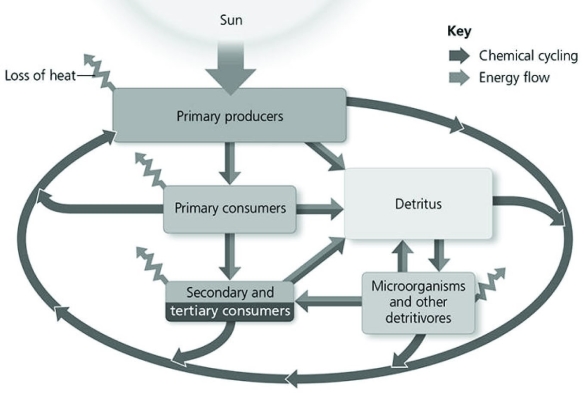 In the figure, the jagged arrow leaving microorganisms and other detritivores represents which process?
In the figure, the jagged arrow leaving microorganisms and other detritivores represents which process?
A) organic compounds broken down by bacteria
B) energy consumed by bacteria
C) energy lost from a worm during cellular respiration
D) CO2 and heat loss from detritus due to solar radiation and precipitation
Correct Answer

verified
Correct Answer
verified
Multiple Choice
Use the figure to answer the question: 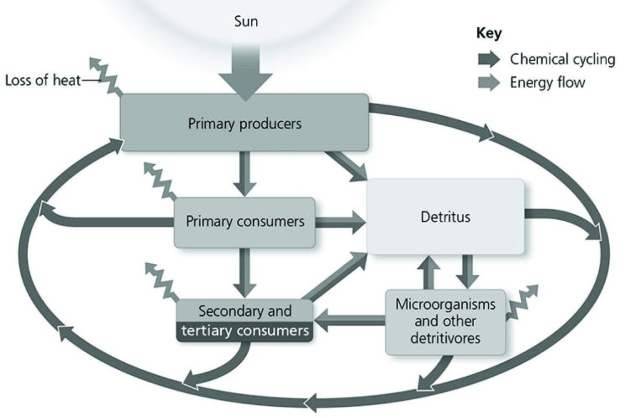 Which arrow, if representing magnitude, should show the largest biomass exiting primary producers?
Which arrow, if representing magnitude, should show the largest biomass exiting primary producers?
A) arrow leading to primary consumers
B) arrow leading to detritus
C) arrow leading back to primary producers
D) loss of heat arrow
Correct Answer

verified
Correct Answer
verified
Multiple Choice
Which one of the following correctly ranks these organisms in order from lowest to highest percent in production efficiency?
A) mammals, fish, insects
B) insects, fish, mammals
C) fish, insects, mammals
D) mammals, insects, fish
Correct Answer

verified
Correct Answer
verified
Multiple Choice
Use the following figure to answer the question.  In the ecosystem figure, which component of the food web has the potential to lose the most energy as heat?
In the ecosystem figure, which component of the food web has the potential to lose the most energy as heat?
A) secondary and tertiary consumers
B) primary consumers
C) primary producers
D) microorganisms and other detritivores
Correct Answer

verified
Correct Answer
verified
Multiple Choice
Use the figure to answer the question: 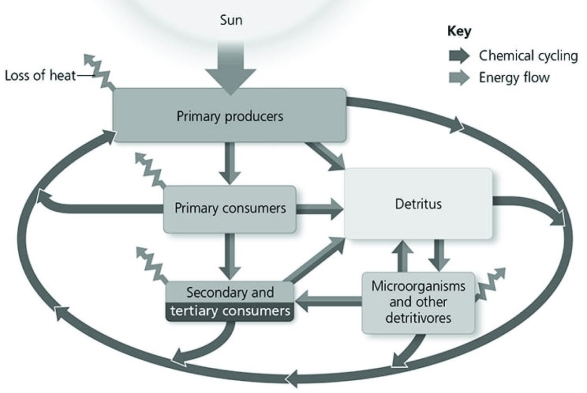 The blue arrow exiting the left side of the "Primary consumers" box could best be described as which of the following examples of a nutrient transfer?
The blue arrow exiting the left side of the "Primary consumers" box could best be described as which of the following examples of a nutrient transfer?
A) decomposition of dead matter
B) feces excreted by the primary consumer
C) predation of the primary consumer
D) production consumed by the primary consumer
Correct Answer

verified
Correct Answer
verified
Multiple Choice
Which of the following is a reason that a diet consisting primarily of fruits and vegetables results in a smaller ecological footprint than a diet high in meat content?
A) Fewer animals are raised for human consumption.
B) There is an excess of plant biomass in all terrestrial ecosystems.
C) Vegetarians require less chemical energy than others
D) Eating meat is an inefficient way of acquiring photosynthetic productivity.
Correct Answer

verified
Correct Answer
verified
Multiple Choice
A group of students walking through a coastal rainforest in Vietnam observe a large, beautiful tree towering above. The tree is full of orchids, mosses, birds, insects, arachnids, and millions of bacteria, all interacting with the abiotic environment, including the air, soil, and water of the forest. Which of the following terms bests describe this in the entirety of what they are observing?
A) habitat
B) microcosm
C) ecosystem
D) community
Correct Answer

verified
Correct Answer
verified
Multiple Choice
Many of the organisms in the ocean are nutrient-limited. Which of the following would be the most reasonable approach if you wanted to investigate this phenomenon?
A) observe Antarctic Ocean productivity from year to year to see if it changes
B) experimentally enrich some areas of the ocean and compare their productivity to that of untreated areas
C) compare nutrient concentrations between the photic zone and the benthic zone in various marine locations
D) contrast nutrient uptake by autotrophs in marine locations that are different temperatures
Correct Answer

verified
Correct Answer
verified
Showing 21 - 40 of 80
Related Exams